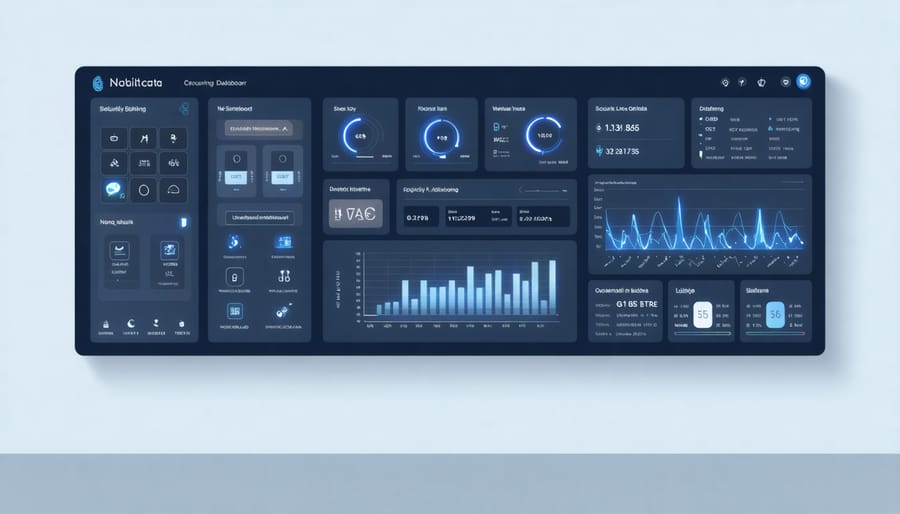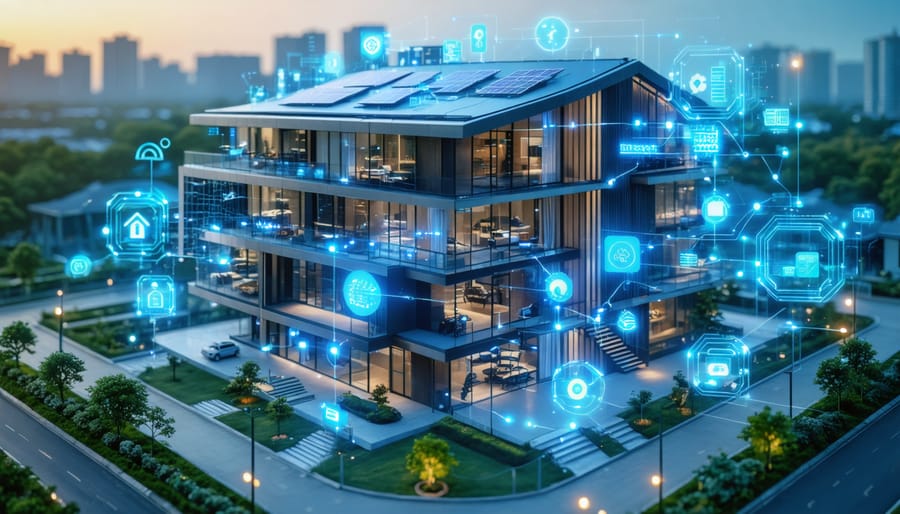Building automation control systems are revolutionizing modern facility management, delivering energy cost savings of up to 40% while enhancing occupant comfort and operational efficiency. These intelligent systems integrate HVAC, lighting, security, and environmental controls into a unified network, enabling real-time monitoring and automated response protocols across entire building portfolios.
As the cornerstone of smart building technology, modern automation controls leverage advanced sensors, machine learning algorithms, and IoT connectivity to optimize resource utilization and predict maintenance needs before failures occur. Industry leaders implementing these solutions report significant improvements in facility performance metrics, including reduced downtime, enhanced security protocols, and streamlined facility management workflows.
For construction professionals and facility managers, understanding the strategic implementation of building automation controls has become essential for delivering high-performance buildings that meet increasingly stringent efficiency standards and occupant expectations. The integration of these systems represents a critical investment in future-proofing facilities while providing immediate operational benefits and substantial return on investment through reduced operating costs and improved asset longevity.

Core Building Automation Control Systems
HVAC Control Systems
Modern HVAC control systems represent the cornerstone of building automation, combining sophisticated sensors, smart controllers, and advanced algorithms to optimize both comfort and energy efficiency. These systems utilize a network of temperature, humidity, occupancy, and CO2 sensors strategically placed throughout the building to maintain ideal environmental conditions while minimizing energy consumption.
At the heart of HVAC automation are Direct Digital Control (DDC) systems, which provide precise control over heating, cooling, and ventilation equipment. These controllers implement complex scheduling, setpoint management, and demand-response strategies based on real-time data and predefined parameters. Variable Air Volume (VAV) systems, equipped with smart dampers and sensors, adjust airflow rates automatically to match actual space requirements.
Energy optimization features include adaptive start/stop algorithms that learn building thermal characteristics to optimize equipment runtime, economizer controls that leverage free cooling when outdoor conditions permit, and demand-controlled ventilation that adjusts fresh air intake based on occupancy levels. Advanced analytics platforms continuously monitor system performance, identifying inefficiencies and maintenance needs before they impact operations.
Integration capabilities allow HVAC controls to communicate with other building systems, enabling coordinated responses to changing conditions. For example, occupancy data from access control systems can trigger temperature adjustments, while lighting controls can inform cooling requirements based on heat load from artificial lighting.
Lighting Automation
Modern lighting automation systems represent a significant advancement in building control technology, offering sophisticated solutions for energy efficiency and occupant comfort. These systems integrate three key components: advanced lighting controls, occupancy sensing, and daylight harvesting technologies.
Advanced lighting controls utilize programmable interfaces and networked fixtures to manage illumination levels throughout a facility. Building managers can create customized lighting schedules, implement dimming protocols, and adjust light output based on specific zone requirements. These controls can be accessed through centralized building management systems (BMS) or mobile applications, offering unprecedented flexibility in lighting management.
Occupancy sensing technology has evolved beyond simple motion detection. Modern sensors combine multiple detection methods, including passive infrared, ultrasonic, and micro-radar technologies, to accurately determine space utilization. These sophisticated sensors can distinguish between different types of movement and occupancy patterns, enabling more precise control and reducing false triggers that plague simpler systems.
Daylight harvesting systems automatically adjust artificial lighting levels in response to available natural light. Photo sensors continuously monitor ambient light levels and communicate with lighting controls to maintain optimal illumination while minimizing energy consumption. This technology can reduce lighting energy costs by 20-60% in perimeter spaces with regular daylight exposure.
Integration of these three components creates a responsive lighting ecosystem that automatically adapts to changing conditions while maintaining optimal light levels for occupant productivity and comfort. When properly implemented, these systems typically achieve payback periods of 2-4 years through reduced energy consumption and maintenance costs.
IoT Integration and Smart Sensors
Wireless Sensor Networks
Wireless sensor networks (WSNs) represent a cornerstone of modern building automation systems, enabling unprecedented levels of monitoring and control throughout facilities. These networks consist of distributed autonomous sensors that monitor physical conditions such as temperature, humidity, occupancy, and energy consumption, forming an intelligent mesh of data collection points across the building infrastructure.
The implementation of WSNs offers several key advantages in building automation. First, the elimination of traditional wiring reduces installation costs by up to 30% while providing greater flexibility for sensor placement. This wireless architecture also simplifies retrofitting existing buildings with smart capabilities, as sensors can be installed without disrupting operations or requiring extensive renovations.
Advanced IoT sensors for predictive maintenance integrate seamlessly with these networks, enabling real-time monitoring of equipment performance and early detection of potential failures. The self-healing nature of modern WSNs ensures reliable communication even if individual nodes fail, maintaining system integrity and data flow.
Recent developments in low-power wireless protocols have extended sensor battery life to 5-10 years, significantly reducing maintenance requirements. Additionally, advanced encryption protocols and security measures protect these networks from unauthorized access, ensuring data integrity and system security.
Building managers can leverage WSN data through centralized management platforms, enabling automated responses to environmental changes and occupancy patterns. This integration results in optimized energy usage, improved occupant comfort, and reduced operational costs, with typical energy savings ranging from 20% to 30% annually.

Data Collection and Analysis
Modern building automation systems rely on a sophisticated network of IoT sensors and data collection devices strategically positioned throughout the facility. These sensors continuously monitor various parameters including temperature, humidity, occupancy levels, energy consumption, and equipment performance. The collected data serves as the foundation for real-time building analytics and intelligent control decisions.
Data processing occurs at multiple levels within the automation system. Edge computing devices perform initial data filtering and analysis directly at the sensor level, reducing network traffic and enabling faster response times. This preprocessed information is then transmitted to central building management systems (BMS) through secure protocols such as BACnet or Modbus.
The BMS employs advanced algorithms and machine learning capabilities to analyze patterns, identify anomalies, and optimize building operations. These systems can predict maintenance requirements, adjust environmental conditions based on occupancy patterns, and automatically implement energy-saving strategies.
Integration with cloud platforms enables deeper analysis and cross-building comparison, providing facility managers with comprehensive insights through intuitive dashboards. The system generates detailed reports on key performance indicators (KPIs), enabling data-driven decision-making for operational improvements and resource allocation.
Modern analytics platforms also incorporate fault detection and diagnostics (FDD) capabilities, automatically identifying potential equipment issues before they lead to failures. This predictive approach significantly reduces maintenance costs and improves system reliability, while ensuring optimal building performance and occupant comfort.
Real-World Applications and ROI
Commercial Office Buildings
Commercial office buildings represent one of the most sophisticated implementations of building automation control systems, where multiple subsystems work in concert to create optimal working environments while maximizing energy efficiency. Modern office complexes typically integrate HVAC, lighting, access control, and security systems through a centralized building management system (BMS).
A prime example is the recently completed Tower 185 in Frankfurt, which employs predictive analytics and digital twins technology to optimize its operations. The building’s automation system processes data from over 50,000 sensors to maintain precise temperature control while reducing energy consumption by 32% compared to conventional buildings.
Occupancy-based controls have become increasingly prevalent in office environments, with smart sensors determining real-time space utilization. These systems automatically adjust HVAC and lighting settings based on actual usage patterns, reducing energy waste in unused areas while maintaining comfort in occupied spaces.
Advanced implementations often include:
– Integrated access control systems that manage elevator operations and floor access
– Smart lighting systems with daylight harvesting and occupancy sensing
– Demand-controlled ventilation that adjusts fresh air supply based on CO2 levels
– Automated shade controls that optimize natural light while minimizing solar heat gain
– Energy monitoring systems that provide detailed consumption analytics
The ROI for these systems in commercial office buildings typically manifests within 3-5 years through reduced operational costs, improved tenant satisfaction, and increased property value. For instance, the Wells Fargo Center in Minneapolis achieved annual energy savings of $352,000 after implementing comprehensive building automation controls.
These systems also support green building certifications like LEED and BREEAM, which can command premium rental rates and attract environmentally conscious tenants. Modern office buildings increasingly leverage these technologies to create smarter, more sustainable workspaces while delivering tangible business benefits.

Industrial Facilities
Industrial facilities require sophisticated building automation control systems to manage complex manufacturing processes, maintain strict environmental conditions, and ensure operational efficiency. These systems integrate multiple components, including programmable logic controllers (PLCs), distributed control systems (DCS), and supervisory control and data acquisition (SCADA) platforms to orchestrate facility-wide operations.
In manufacturing environments, automation controls regulate critical parameters such as temperature, humidity, air pressure, and ventilation to maintain optimal production conditions. Advanced sensor networks monitor equipment performance, energy consumption, and environmental factors in real-time, enabling predictive maintenance and reducing downtime.
Process control systems in industrial settings often incorporate safety interlocks and emergency shutdown protocols to protect personnel and equipment. These systems monitor potentially hazardous conditions and automatically initiate appropriate responses when predetermined thresholds are exceeded.
Energy management is particularly crucial in industrial facilities, where automation controls optimize HVAC systems, lighting, and equipment operation schedules. Smart scheduling algorithms adjust equipment runtime based on production schedules, while demand response capabilities help facilities participate in utility incentive programs.
Modern industrial automation systems also feature:
– Real-time production monitoring and reporting
– Quality control integration
– Environmental compliance tracking
– Resource consumption optimization
– Remote monitoring and control capabilities
Integration with Manufacturing Execution Systems (MES) and Enterprise Resource Planning (ERP) platforms enables comprehensive facility management. This connectivity provides valuable data for operational analysis, helping facility managers identify inefficiencies and optimize processes.
The implementation of Industrial Internet of Things (IIoT) devices has further enhanced automation capabilities, enabling better communication between systems and more sophisticated data analytics. These smart devices provide granular control over individual processes while contributing to overall facility optimization.
Case studies have shown that properly implemented industrial automation controls can reduce energy consumption by 20-30% while improving production efficiency by 15-25%. This combination of benefits makes automation control systems an essential component of modern industrial facility operations.
Future-Proofing Building Control Systems

AI and Machine Learning Integration
Artificial Intelligence and Machine Learning are revolutionizing building automation control systems by introducing predictive capabilities and autonomous decision-making processes. Modern building management systems now leverage AI algorithms to analyze vast amounts of sensor data, enabling real-time optimization of HVAC systems, lighting controls, and security protocols.
Machine learning models continuously learn from historical building performance data, occupancy patterns, and environmental conditions to make intelligent adjustments that improve energy efficiency and occupant comfort. For example, AI-powered systems can predict peak usage times and automatically adjust temperature settings to optimize energy consumption while maintaining optimal comfort levels.
These smart systems also excel at fault detection and predictive maintenance. By analyzing equipment performance patterns, AI algorithms can identify potential system failures before they occur, allowing facility managers to schedule maintenance proactively rather than reactively. This predictive approach significantly reduces downtime and maintenance costs while extending equipment life spans.
Advanced neural networks are now being employed to manage complex building ecosystems, integrating multiple subsystems and optimizing their collective performance. These systems can automatically adjust ventilation based on CO2 levels, manage lighting based on natural light availability, and control access systems based on real-time security requirements.
Recent implementations have demonstrated energy savings of up to 30% in commercial buildings utilizing AI-enhanced control systems, while also improving occupant satisfaction through more responsive and personalized environmental controls.
Scalability and Expansion
When designing building automation systems, scalability must be a cornerstone of the initial planning phase. Future-proofing your installation ensures that the system can adapt to evolving technological advances and expanding facility requirements without requiring complete overhauls. This approach not only protects your initial investment but also provides flexibility for future growth.
A well-planned scalable system should incorporate modular components that allow for easy expansion of both hardware and software elements. This includes ensuring adequate network infrastructure capacity, selecting controllers with expandable I/O capabilities, and implementing software platforms that support additional features and integrations.
Key considerations for scalability include:
– Implementing open protocols and standards that facilitate third-party integration
– Selecting hardware with surplus capacity for additional sensors and control points
– Ensuring network infrastructure can handle increased data loads
– Planning for redundancy and backup systems
As systems grow more complex, building automation security becomes increasingly critical. Each expansion point must be evaluated for potential vulnerabilities and protected accordingly.
Industry best practices recommend maintaining a detailed expansion roadmap that outlines potential growth areas, technology upgrade paths, and integration requirements. This strategic approach ensures that system modifications can be implemented efficiently while maintaining operational continuity and minimizing disruption to existing services.
Building automation control systems represent a significant advancement in modern construction and facility management, offering substantial benefits when properly implemented. The integration of these systems consistently demonstrates ROI through reduced energy consumption, improved operational efficiency, and enhanced occupant comfort. Organizations implementing comprehensive building automation solutions typically report energy savings of 20-30% and maintenance cost reductions of up to 40%.
However, successful implementation requires careful planning, considering factors such as system scalability, integration capabilities, and long-term maintenance requirements. Organizations must assess their specific needs, technical capabilities, and budget constraints before selecting appropriate control devices and applications. Training staff and establishing clear operational protocols are equally crucial for maximizing system benefits.
Looking ahead, the continued evolution of IoT technology and artificial intelligence will further enhance building automation capabilities. Organizations that invest in flexible, future-ready systems today position themselves to adapt to emerging technologies while maintaining operational excellence. By carefully weighing these considerations and working with experienced providers, businesses can successfully navigate the implementation process and achieve optimal results from their building automation investments.

